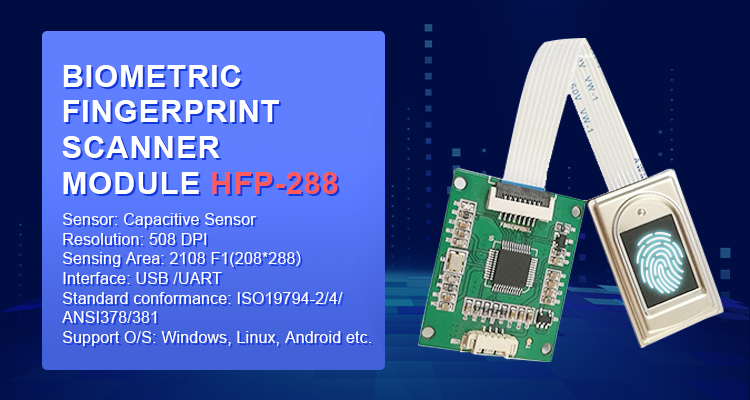| Availability: | |
|---|---|
| Quantity: | |
HFP-288
HCCTG
HFP-288 Biometric Fingerprint Scanner Module is a cutting-edge solution that enhances security and access control with its advanced features. This module seamlessly communicates with the master device using two versatile communication protocols: USB and UART. This ensures compatibility with a wide range of systems, providing flexibility in integration.
Designed to operate as a slave device, the HFP-288 module responds to commands from the master device, enabling efficient and secure control. The connection between the main device and the module is established through a reliable 4PIN * 1.25 electronic cable, ensuring a stable and robust connection.
Key Features:
Biometric Fingerprint Scanning: Enjoy state-of-the-art biometric security with the HFP-288 module, providing accurate and reliable fingerprint scanning for enhanced access control.
Dual Communication Protocols: The module supports both USB and UART communication protocols, offering compatibility with a variety of systems and applications.
Slave Device Functionality: As a slave device, the HFP-288 module effortlessly follows commands from the master device, ensuring seamless integration and control.
Secure Connection: The module is connected to the main device through a 4PIN * 1.25 electronic cable, guaranteeing a secure and stable connection for optimal performance.
Versatile Integration: With its versatile communication protocols and reliable connectivity, the HFP-288 module is suitable for diverse applications, including access control systems, time and attendance solutions, and more.

Specification
Item | Value |
Resolution | 500 Dpi |
Sensor | ·Capacitive sensor ·208 * 288 mm ·RoHS certification ·IP67 waterproof grade ·Support ANSI algorithm, ISO algorithm ·ESD air ± 15KV, air ± 8KV |
Customized support | Customized logo, OEM, ODM, Software reengineering |
Communication | USB / UART |
Operation System | Windows, Linux, Android etc. |
Application | Software Integration |
SDK | JAVA. C# |
Standards Compliance | ISO19794-2/4/ANSI378/381 |
HFP-288 Biometric Fingerprint Scanner Module is a cutting-edge solution that enhances security and access control with its advanced features. This module seamlessly communicates with the master device using two versatile communication protocols: USB and UART. This ensures compatibility with a wide range of systems, providing flexibility in integration.
Designed to operate as a slave device, the HFP-288 module responds to commands from the master device, enabling efficient and secure control. The connection between the main device and the module is established through a reliable 4PIN * 1.25 electronic cable, ensuring a stable and robust connection.
Key Features:
Biometric Fingerprint Scanning: Enjoy state-of-the-art biometric security with the HFP-288 module, providing accurate and reliable fingerprint scanning for enhanced access control.
Dual Communication Protocols: The module supports both USB and UART communication protocols, offering compatibility with a variety of systems and applications.
Slave Device Functionality: As a slave device, the HFP-288 module effortlessly follows commands from the master device, ensuring seamless integration and control.
Secure Connection: The module is connected to the main device through a 4PIN * 1.25 electronic cable, guaranteeing a secure and stable connection for optimal performance.
Versatile Integration: With its versatile communication protocols and reliable connectivity, the HFP-288 module is suitable for diverse applications, including access control systems, time and attendance solutions, and more.

Specification
Item | Value |
Resolution | 500 Dpi |
Sensor | ·Capacitive sensor ·208 * 288 mm ·RoHS certification ·IP67 waterproof grade ·Support ANSI algorithm, ISO algorithm ·ESD air ± 15KV, air ± 8KV |
Customized support | Customized logo, OEM, ODM, Software reengineering |
Communication | USB / UART |
Operation System | Windows, Linux, Android etc. |
Application | Software Integration |
SDK | JAVA. C# |
Standards Compliance | ISO19794-2/4/ANSI378/381 |